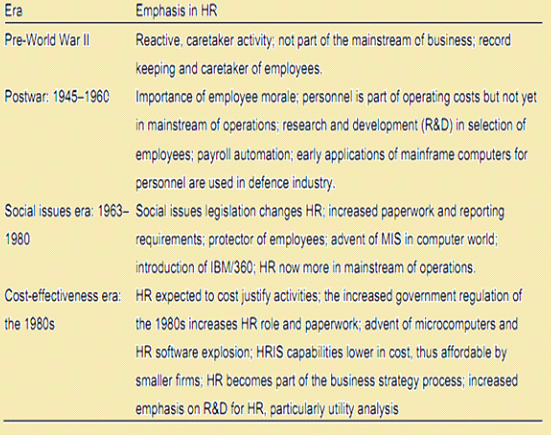HRIS: An Evaluation of its Cost and Benefits
April 3, 2025
 HRIS: An Evaluation of its Cost and Benefits
HRIS: An Evaluation of its Cost and Benefits
Human Resource Information System (HRIS) often described as Human Resource Management System, in the present scenario can serve as a crucial tool in providing a competitive advantage to the organizations. It involves measurability, better management of data and information, equally provide scope for measurement of key HR practices and its outcomes on employee productivity as…
 Training & Development and HRIS Applications
Training & Development and HRIS Applications
HRIS is a systematic process of compiling different information for easily accessing them further. HRIS helps in training and development issues within a business. It facilitates performance evaluation of an employee understanding proper training methods, utilizing the knowledge imparted to employees in an accessible manner. Training and Development – Strategic Implications and Learning Organization The…
 Systems Considerations in the Design of HRIS
Systems Considerations in the Design of HRIS
For implementing any Human Resource Information System (HRIS) project successfully, the system design requirements should be given utmost importance and it must have scope for customizations as per the requirements of the end users. The system should have various inbuilt provisions and be developed by carefully analyzing the end users/customers’ requirements and the technicalities involved…
In the contemporary scenario of modernization and globalization, organizations heavily rely upon technological advancement and innovation in the field of Information Technology.
Advancements in the field of IT has opened up newer avenues for the organizations and provided a competitive advantage by using innovative and customized solutions. It has become an integral part of the organizational functioning and all the departments depend on integrated systems for organizing, storing, retrieving and reviewing data. Today Internet and automation has facilitated accessibility, reliability and accuracy of information; improved organizational effectiveness and provided a leadership edge by applying technology in various operations.
Human Resource Management function is fast evolving and the application of Information Technology has revolutionized the way in which organizations operate.
The field of Human Resource Management has been continuously evolving and the HR in today’s scenario is playing a strategic role than merely a support system. Human Resource function primarily deals with the employees, employers and all the people who are related with the organization. It is designed to improve employee productivity, performance and align the workforce with the business.
The HRM functions in an organization deals with people related issues like Recruitment Selection, Compensation, General Administration, Employee Welfare and Involvement, Communication, Organizational Development, Performance Management, Employee Motivation, Rewards Recognitions and Training Development.
HRIS or Human Resource Information System, is a customized software solution designed for helping the organizations to automate and manage their HR, payroll, management and accounting activities. HRIS affects the performance of the people, processes and key organizational strategies by automating key HR processes like recruitment, training, manpower planning, performance appraisal and job analysis design.
HR software mechanizes the day to day general and administrative functions performed by the HR department, enhances overall employee productivity and performance. HRM applications can be used for updating and recording employee information, its usage can make the recruitment process more robust and effective.
HRMS facilitates applicant tracking, interviewing and confirmation process. Apart from this, the workforce administration strategies can be streamlined and it can generate various cost advantages to the organizations by streamlining various functional operations.
Human resource management system or HR Package (HR solutions) can be used in training processes, tracking employee performance and participation (performance management system), payroll management system and accounting, benefits and leaves.
In a nutshell, HRMS offers distinctive advantages to the organizations by automating various functions of HRM, thereby reducing the workload of the HR department and increasing the efficiency of the department by standardizing key HR processes.
According to Parry (2010), HRIS can serve as a vital strategic tool as it shares crucial data with the management related with recruitment and retention strategies which can be aligned with the overall corporate strategy for realizing the organizational objectives of growth. Additionally, by using HR applications, a company can calculate the overall costs incurred per employee and it’s effects on the business as a whole (DeSanctis, 1986).
Historical data reveals that the evolution of HRIS can be traced back in 1950’s and 1960’s when the first automated systems (payroll system) was introduced (Martinsons 1997). Kavanagh et al. (1990) shared their insights on historical evolution of HRIS by introducing the historical eras in human resource from the pre-World War II period to the 1980s and how the evolving HR practices had its effect on the HRIS.
With the increasing importance of IT applications in HR, the functioning of HR department has been undergoing a radical change from mere administrative and support functions to a more active participant in the strategic decisions of the organization.
Historical eras in HR (Source: Kavanagh et al. 1990, Pp: 7)

During 1990’s, extensive studies were undertaken on the advantages of the introducing HRIS in the organization and its influence on the overall human resource strategies and business planning. Several theorists advocated the advantages of using HRIS and the organizations were considered to be more competitive if they had a well-equipped HRIS to support HR functions.
Key features which an HR application must have are:
Your email address will not be published. Required fields are marked *